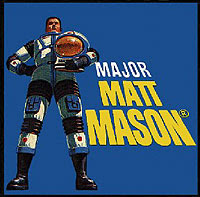Submitted 2002.04.22 by Pat LeBlanc
Lacking any injection molding equipment, the new glider would have to be solid as compared to the XRG-1 plastic shell. Balsa wood and styrofoam are light and easy to work with but they are brittle and not very strong. Remembering the crashes that my childhood XRG-1 experienced, I knew that the wings would be the first casualty. This led me to consider a wingless glider also known as a lifting body.
 |
| X-24A Lifting Body |
Concept
Several lifting body designs were tested at Edwards AFB in the late sixties as part of the USAF/NASA program that led to the development of the Space Shuttle. I chose the X-24A. The X-24A was the basis for the X-RV seen in the 1969 movie "Marooned" and the recently (unfortunately) cancelled X-38 which was to be the Crew Return Vehicle from the International Space Station.
SIG Manufacturing sells "Flite Foam" styrofoam blocks for model airplanes. I bought a 4" x 12" x 48" block for about $12. The plan was to transfer the side elevation of the X-RV to the 4" high side and cut it with a bandsaw. However, my bandsaw wasn't large enough to cut all the way through the 12" side so I cut the block down the middle leaving me with two pieces 4" x 6" x 48" each. Having two pieces would require cutting the side view twice but it made hollowing out the cockpit and what I call the launch chamber much easier.
I printed out a three-view sketch (above) of the X-24A from the internet and blew it up on a copier until it was the same 1/12 scale as the Major. The glider is about 24" long and 12" wide. You may notice some differences between the finished glider and the three-view sketch. The bottom is flatter and the pilot's canopy is flush (think about it: if you're coming back from orbit, would you really want your head sticking out like in the XRG-1?). The finished glider more closely resembles the X-RV (I also wanted to distinguish it from the white and black color scheme of the XRG-1 and the Space Shuttle).
 |
| Flite Foam by SIG |
 |
| Propulsion! |
Modeling
Once the hollowing out was complete, I transferred the side elevation to the 4" side of each block and cut it with the bandsaw. I then used Elmer's glue to assemble the two halves. The next step was to transfer the plan view to the top of the assembly and cut out the plan view. It was starting to look like a lifting body except that the front elevation was rectangular instead of rounded.
 |
| Shaping Tools |
Next I cut several pieces of plywood into curved shapes and covered them with sandpaper. I used these tools to round off the corners. The sandpaper left a few gouges in the Styrofoam that later had to be filled in with spackle and re-sanded. But I decided to leave the surface a little rough since this craft has been traveling back and forth from space for thirty years. Compare the front elevation of the finished glider with the blue prototype (the prototype was made from foam board insulation that is more durable but also heavier and harder to shape).
 |
| Pat LeBlanc's X-RV Lifting Body Top |
 |
| Pat LeBlanc's X-RV Lifting Body Side |
 |
| Pat LeBlanc's X-RV Lifting Body Front |
 |
| Pat LeBlanc's X-RV Lifting Body Rear |
I cut slots in the body, attached the angled side fins and sanded the joints. Spackle was again used to blend the fins into the body. The next step was to seal the styrofoam before painting. It is VERY important to seal the styrofoam because there are components in spray paint that will eat up styrofoam. I chose Elmer's glue again because it's cheap, easy to work with and would also toughen up the skin. I put two coats on the top of the X-RV and three coats on the bottom.
I then painted the X-RV a dull red as seen in the movie "Marooned" and added decals that I created on my computer. I also added black electrical tape to the nose to toughen it up for the inevitable crashes. Major Matt slides into the cockpit and the canopy (which is a folded plastic sheet) snaps into the diamond-shaped opening.
 |
| Ready to Launch! |
 |
| Pat LeBlanc's X-RV Lifting Body with MMM for Scale |
Decals and Resources
Here's a link to a good potato gun site http://www.borked.org/~wax/graphic.potatogun.html. My cannon has a 1" barrel and a 2" combustion chamber. I use Right Guard as the propellant.
The decals were created with Lotus Freelance or downloaded off of the internet and printed out with Lotus WordPro here. Sorry about the format, I'm working with John to produce a file that can be viewed/printed by anyone.
Some additional images
You can contact Pat through Facebook about his amazing custom here.
All Mattel images and captions are copyright Mattel and used without permission. All other content, including images and editorial, is Copyright © 1997-2023 John Eaton and/or contributors unless otherwise stated. If there are any comments or objections, please contact John Eaton.












No comments:
Post a Comment